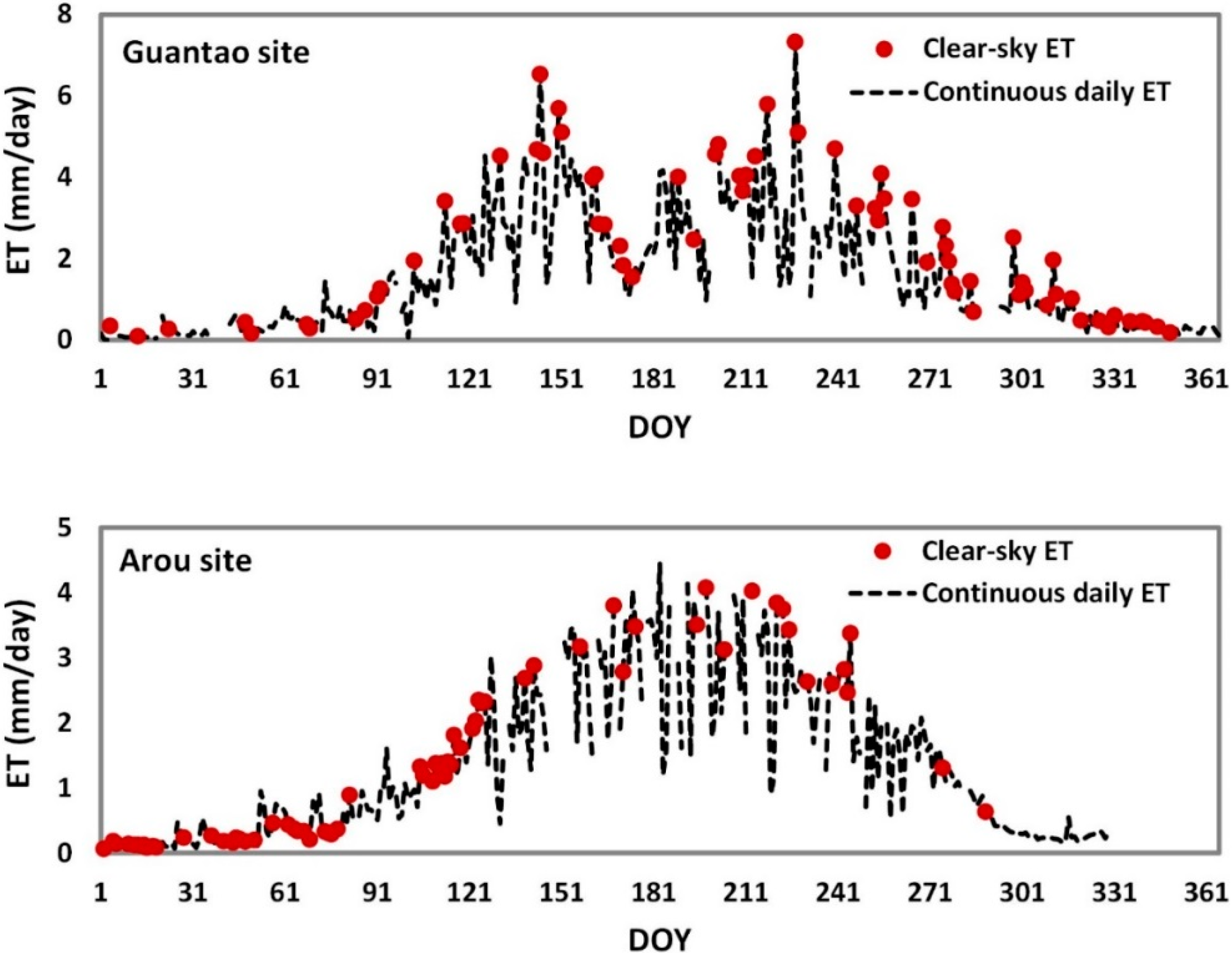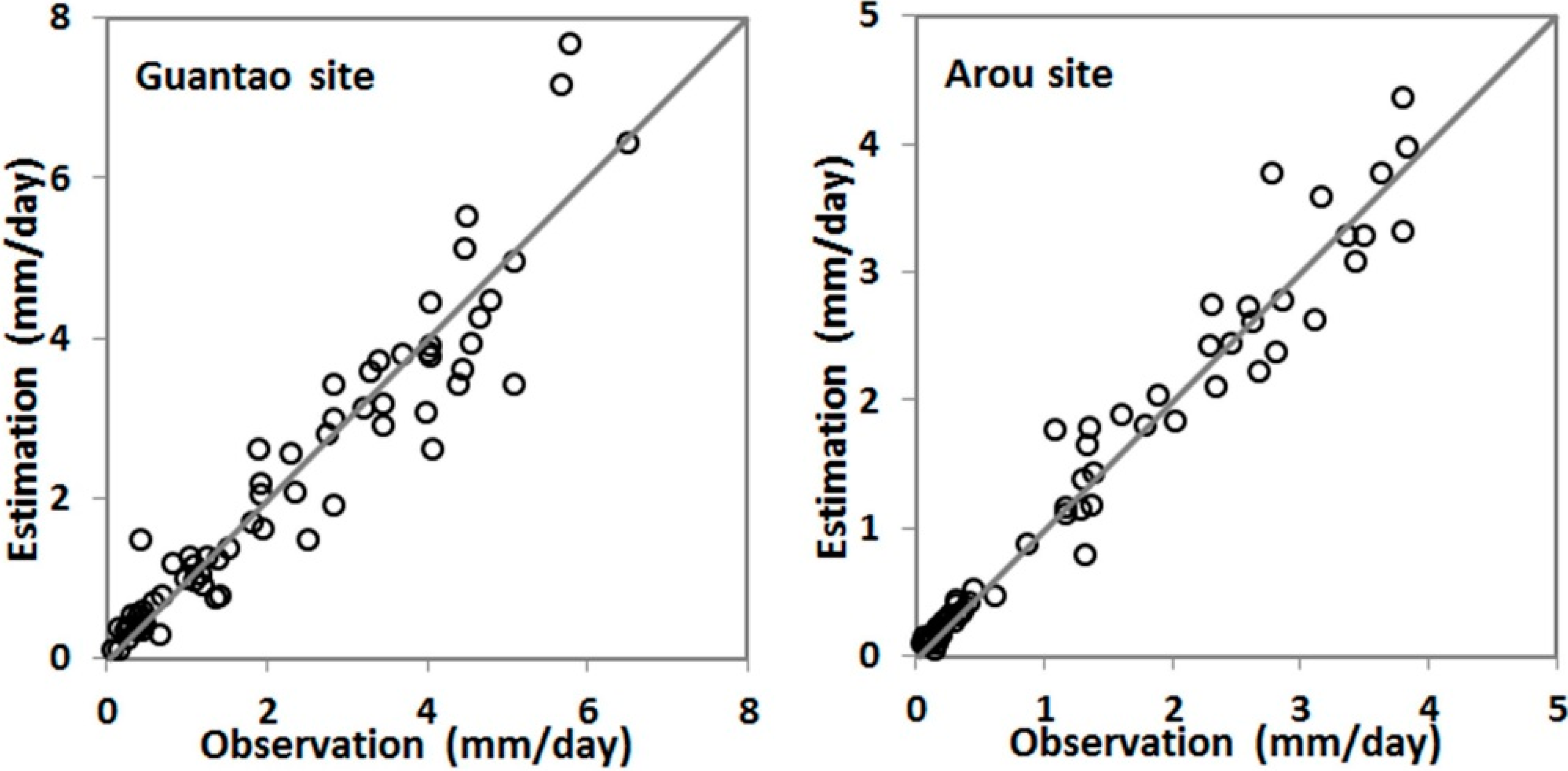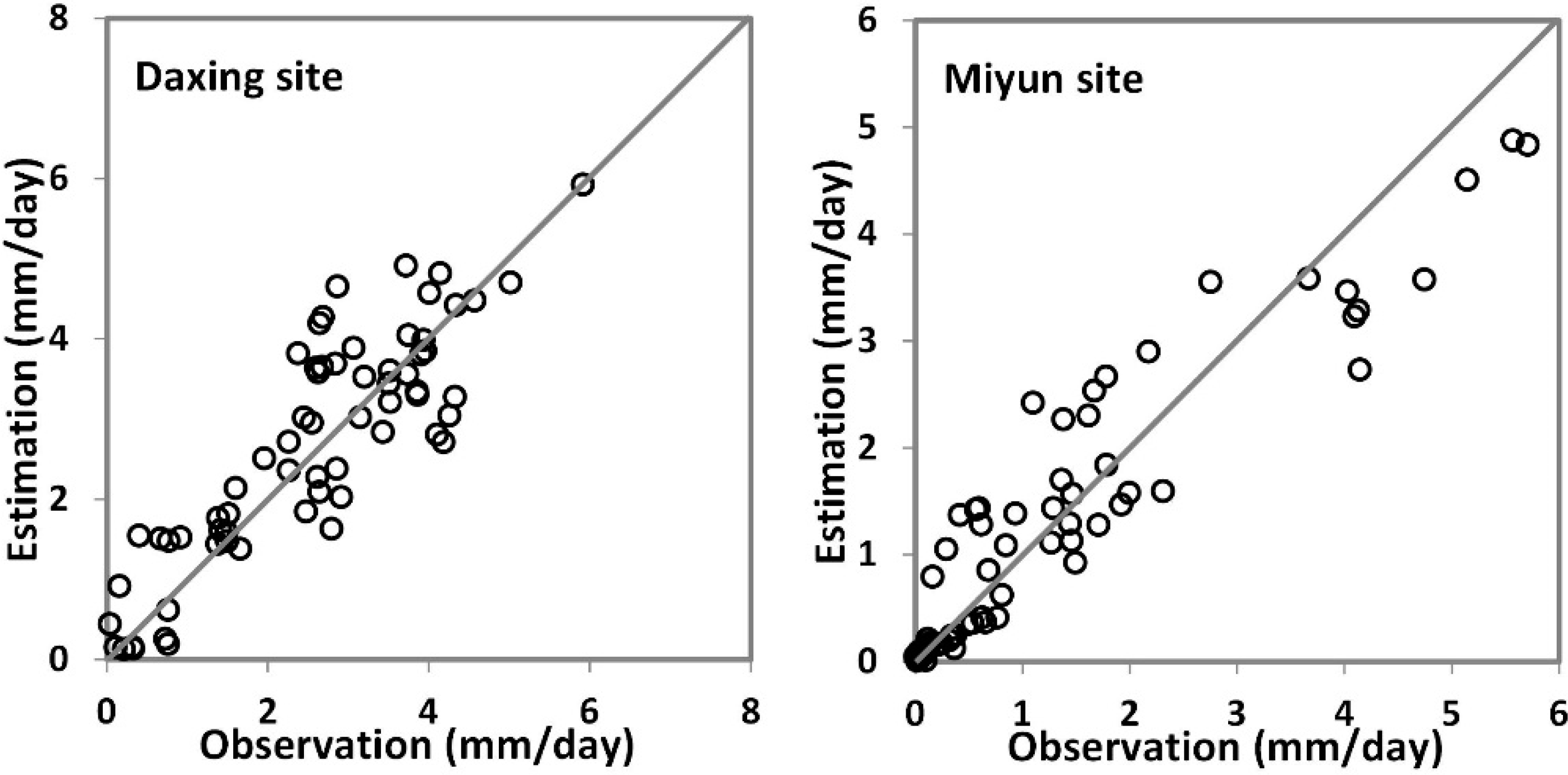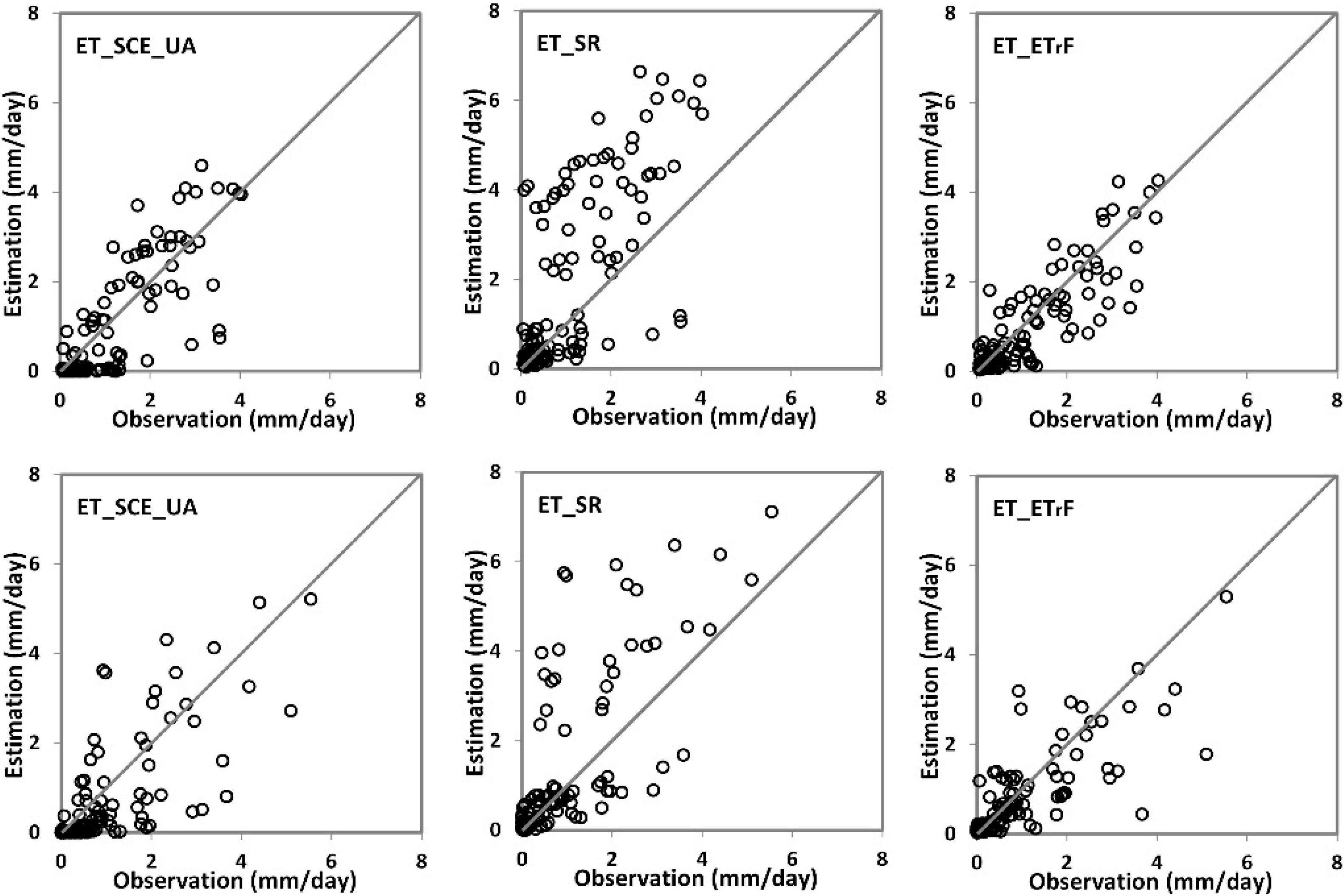4.1. In Situ Validation
The five temporal upscaling methods and five temporal reconstruction approaches were tested and compared with EC-derived ET observations at the Guantao (for 2010) and Arou (for 2009) sites. The mean relative error (MRE), root mean square error (RMSE) and correlation (R) were used to assess the results.
The temporal upscaling results from the five methods were compared with the daily clear-sky ET observations (see
Table 4). The RMSE values of the five methods were all within 1 mm/day and the R values were all larger than 0.89. The SolRad and ConET
rF methods were the two best upscaling methods, as indicated by the smallest RMSE values and largest R values. The MRE values indicated that the ConEF method significantly underestimated the daily ET by 19.1% and 14.1% at the Guantao and Arou sites, respectively. Since many studies have indicated that “self-preserving” will lead to an approximately 5%–10% underestimation of the daytime ET, 10% was added to the ET values for the CorEF method, to correct the underestimation, which led to an 8.1% and 8.6% reduction in MRE at the Guantao and Arou sites. However, the CorEF method still underestimated the daily ET, because nighttime ET was not accounted for. The DiEF method accounted for the nighttime ET by using three factors that enhance the daily ET estimates with the daytime instantaneous data. The MRE values for the DiEF method were near zero. Similarly, the SolRad and ConET
rF methods had MRE values around zero, which indicates that these three methods had little bias in ET temporal upscaling. Moreover, SolRad and ConET
rF methods had smaller RMSE than DiEF, indicating that the ratio between latent heat flux (ET) and solar radiation or reference ET was more stable than EF. According to Gentine
et al. [
15], EF is higher during early morning and late afternoon than it is midday. Here, Similar to the finding of previous studies [
23,
24], this phenomenon caused underestimation of the daytime average EF from midday EF observations with the ConEF method. However, the ConET
rF method upscales ET with daily
ETr, which is better at capturing the impacts of advection, changing wind, and changing humidity conditions during the day with the reference ET included [
28].
Table 4.
The statistics of the five temporal upscaling methods at the Guantao and Arou sites.
Table 4.
The statistics of the five temporal upscaling methods at the Guantao and Arou sites.
| Site | Season | Statistics | ConEF | CorEF | DiEF | SolRad | ConETrF |
|---|
| Guantao | Vegetation, growing | MRE (%) | −13.0 | −4.3 | 4.4 | −2.1 | −1.4 |
| RMSE (mm/day) | 0.79 | 0.80 | 0.96 | 0.70 | 0.65 |
| R (-) | 0.93 | 0.93 | 0.93 | 0.93 | 0.93 |
| Vegetation, dormant | MRE (%) | −29.5 | −22.4 | −15.4 | −11.2 | 0.91 |
| RMSE (mm/day) | 0.58 | 0.51 | 0.54 | 0.33 | 0.33 |
| R (-) | 0.96 | 0.96 | 0.96 | 0.98 | 0.98 |
| Overall | MRE (%) | −19.1 | −11.0 | −2.7 | −6.9 | −1.3 |
| RMSE (mm/day) | 0.76 | 0.71 | 0.79 | 0.58 | 0.65 |
| R (-) | 0.94 | 0.94 | 0.94 | 0.95 | 0.93 |
| Arou | Vegetation, growing | MRE (%) | −15.4 | −6.9 | 2.2 | −3.9 | 0.79 |
| RMSE (mm/day) | 0.61 | 0.54 | 0.60 | 0.29 | 0.49 |
| R (-) | 0.89 | 0.89 | 0.89 | 0.97 | 0.98 |
| Vegetation, dormant | MRE (%) | −45.1 | −39.6 | −37.6 | −5.9 | −18.7 |
| RMSE (mm/day) | 0.17 | 0.15 | 0.14 | 0.07 | 0.11 |
| R (-) | 0.98 | 0.98 | 0.98 | 0.98 | 0.97 |
| Overall | MRE (%) | −14.1 | −5.5 | 3.2 | −3.4 | 0.9 |
| RMSE (mm/day) | 0.64 | 0.65 | 0.70 | 0.21 | 0.39 |
| R (-) | 0.89 | 0.89 | 0.89 | 0.99 | 0.96 |
Among the five upscaling methods, SolRad performed the best during the season of dormant vegetation, and ConET
rF produced the best results during the season of active vegetation growth. Similar findings were obtained by Colaizzi
et al. [
22], which proved that the ConET
rF method performs better during periods of active vegetation growth. Thus, the optimum method is a combination of the SolRad method when vegetation growth is dormant, and the ConET
rF method during periods of active vegetation growth. RMSE values for the optimum method were 0.58 mm/day and 0.25 mm/day for the Guantao and Arou sites, respectively. The corresponding MRE values were −3.7% and 0%. The ET estimates from the optimum method are plotted in
Figure 4.
Figure 4 shows that the ET estimates from the optimum method were close to observational values.
Figure 4.
The comparisons of clear-sky ET estimates from the optimum method with in situ observations.
Figure 4.
The comparisons of clear-sky ET estimates from the optimum method with in situ observations.
The continuous daily ET was reconstructed with discrete accumulated clear-sky daily ET values measured by EC instruments at the Guantao and Arou sites. The cloudy-day ET temporal reconstruction results from the developed data assimilation methods (ET_EnKF and ET_SCE_UA), ET_SR, ET_ET
rF, and ET_HANTS method, were compared with the ET observations (see
Figure 5). As shown, the data assimilation methods and the ET_ET
rF method performed the best, as indicated by the scattering about the 1:1 line. The ET_SR method underestimated the cloudy-day ET significantly, and the ET_HANTS method overestimated.
Figure 5.
The comparisons of cloudy-day ET between the model estimations and observations. (Guantao site result (top); Arou site result (bottom)).
Figure 5.
The comparisons of cloudy-day ET between the model estimations and observations. (Guantao site result (top); Arou site result (bottom)).
The statistics of each temporal reconstruction method are shown in
Table 5. Over the whole time period, the RMSEs of most of the temporal reconstruction approaches were within 1.0 mm/day, except for the ET_HANTS method at the Guantao site (1.06 mm/day). The ET_ET
rF method produced the lowest RMSE values, which were 0.61 and 0.37 mm/day at Guantao and Arou, respectively. MRE values of ET_SCE_UA method were around zero (−5.4% and −2.6% at the Guantao and Arou sites), indicating the lowest ET estimation bias. Of the two data assimilation methods, the ET_SCE_UA approach outperformed the ET_EnKF. As indicated in
Section 2.3.1, the ET_SCE_UA approach can make full use of four neighbored clear-sky ET observations to update the model parameters, while the ET_EnKF method only uses one previous ET observations. Thus, the ET_SCE_UA approach can produce lower errors than ET_EnKF method. The performances of these methods were also analyzed during periods of vegetation growth and dormant vegetation, as shown in
Table 5. The periods of vegetation growth usually had larger RMSEs than periods of vegetation dormancy, and over the entire period, because the ET value was larger in summer than the other seasons, which was caused by higher solar radiation. The MRE values of most methods were closer to zero during periods of vegetation growth than periods of dormant vegetation, except for the ET_HANTS method. The data assimilation, ET_SR, and ET_ET
rF methods were all based on Penman-Monteith equation. Since the key parameter (surface resistance) of the Penman-Monteith equation is parameterized by leaf area index, it may get more accurate results for periods of vegetation growth than periods of vegetation dormancy [
25].
Table 5.
The statistics of temporal reconstruction approaches at the Guantao and Arou sites.
Table 5.
The statistics of temporal reconstruction approaches at the Guantao and Arou sites.
| Site | Season | Statistics | ET_EnKF | ET_SCE_UA | ET_SR | ET_ETrF | ET_HANTS |
|---|
| Guantao | Vegetation, growing | MRE (%) | −7.4 | −0.2 | −13.8 | 9.6 | 41.1 |
| RMSE (mm/day) | 1.14 | 0.81 | 1.20 | 0.80 | 1.53 |
| R (-) | 0.75 | 0.84 | 0.73 | 0.83 | 0.40 |
| Vegetation, dormant | MRE (%) | −53.8 | −22.4 | −56.1 | 14.0 | −28.0 |
| RMSE (mm/day) | 0.43 | 0.51 | 0.44 | 0.41 | 0.44 |
| R (-) | 0.85 | 0.79 | 0.85 | 0.82 | 0.84 |
| Overall | MRE (%) | −18.3 | −5.4 | −23.6 | 10.7 | 24.9 |
| RMSE (mm/day) | 0.81 | 0.66 | 0.85 | 0.61 | 1.06 |
| R (-) | 0.87 | 0.91 | 0.85 | 0.91 | 0.83 |
| Arou | Vegetation, growing | MRE (%) | 12.7 | 0.0 | −19.7 | −6.5 | 21.5 |
| RMSE (mm/day) | 0.60 | 0.48 | 0.80 | 0.45 | 0.98 |
| R (-) | 0.90 | 0.94 | 0.88 | 0.90 | 0.59 |
| Vegetation, dormant | MRE (%) | −3.2 | −31.8 | −73.5 | −19.1 | −39.2 |
| RMSE (mm/day) | 0.51 | 0.33 | 0.52 | 0.30 | 0.30 |
| R (-) | 0.57 | 0.63 | 0.51 | 0.68 | 0.76 |
| Overall | MRE (%) | 9.6 | −2.6 | −25.4 | 10.5 | 12.9 |
| RMSE (mm/day) | 0.57 | 0.41 | 0.66 | 0.37 | 0.73 |
| R (-) | 0.93 | 0.96 | 0.91 | 0.95 | 0.88 |
No soil moisture or precipitation data were used in any of the temporal reconstruction approaches. However, soil moisture may increase suddenly due to precipitation and thermal remote sensing is not able to detect this change during rainy days. The variations of soil moisture will lead to change in ET distributions. Thus, errors may be cut down by developing ET temporal reconstruction methods that can assimilate microwave soil moisture (e.g., SMAP), or precipitation observations. For the ET_HANTS method, the cloudy-sky ET can be estimated based on clear-sky ET observations. However, the clear-sky ET is usually higher than cloudy-sky ET, which is a result of larger values of solar radiation. Without an input for forcing data (e.g., solar radiation, precipitation), the ET_HANTS method cannot detect a sudden decrease in ET caused by clouds. Thus, the estimated cloudy-sky ET from ET_HANTS is usually larger than
in situ measurements, as was found here and is indicated by
Figure 5. Moreover, the ET_HANTS method produced smooth seasonal variation of cloudy-sky daily ET. Thus, the scattering from the ET_HANTS method was sparser than the others (see
Figure 5). The surface resistance in the ET_SR method with cloudy-sky conditions was obtained with the clear-sky values and ancillary parameters (LAI,
m(Tmin) and
m(VPD) functions). Because threshold values of
m(Tmin) and
m(VPD) were constructed based on vegetation types globally [
25], they may not suitable for all specific land cover and climatic condition and should be calibrated with local observations.
Figure 6.
The monthly ET variations from five temporal reconstruction approaches.
Figure 6.
The monthly ET variations from five temporal reconstruction approaches.
The monthly variation of ET at the Guantao and Arou sites is shown in
Figure 6. From
Figure 6, the five methods show similar trends. At the Guantao site, all the methods display dual-peak ET values, caused by different growth patterns of winter wheat and summer corn. The low ebb of the ET estimates is indicative of a crop rotation period, where the winter wheat was cut down and the summer corn was at the early stages of growth. The ET_HANTS method estimated an ET that was larger than the other methods for May and August, which are the months of peak ET for both winter wheat and summer corn. The ET_HANTS overestimated the ET by 24.9% (see
Table 5), which was caused by the large error for these two months at the Guantao site. At the Arou site, all methods depict a single-peak ET trend throughout the year. The ET_HANTS overestimated the ET by 12.9%, which was caused by the large error from May to August.
4.2. Regional Application
In this study, the regional instantaneous clear-sky ET values were estimated by the remotely sensed ET model proposed by Liu
et al. [
5]. The instantaneous ET estimates were upscaled to daily values with the combination of the SolRad and ConET
rF methods (the “optimum method”). The ConEF method was also applied for comparison. Over land surface covered with vegetation (cropland, garden-plot, forest, and grassland in
Figure 2), the SolRad and ConET
rF methods were used for ET upscaling, during periods of vegetation dormancy and growth, respectively. Over land surface without vegetation (urban, water, road, and bare land), the SolRad method was used for ET upscaling over the entire year. In Beijing, the season of vegetation growth is from day of year (DOY) 100–283, for garden-plot, forest, and grassland areas, but for cropland, the season of vegetation growth is from DOY 100–161 and 182–283, according to vegetation phenology. As discussed in
Section 4.1, the ET_ET
rF and ET_SCE_UA methods performed the best out of the ET temporal reconstruction approaches. Thus, those approaches were selected to produce the continuous daily ET with upscaled clear-sky daily ET for the Beijing area. The ET_SR method was also applied in Beijing for comparison. The comparisons between model estimates and the LAS observations are shown in
Figure 7 and
Figure 8.
Figure 7 shows the temporal upscaling results of the instantaneous ET estimates with the optimum method. The model estimates were close to LAS daily ET observations and the scatter plots approximately form 1:1 lines. At the Daxing site, the MRE (RMSE) value was 5.4% (0.72 mm/day). The corresponding MRE (RMSE) for the Miyun site was 0.3% (0.54 mm/day). Thus, the optimum method showed minor bias and low RMSE values at the two sites, which indicates that the optimum method is a suitable thermal ET upscaling method.
Figure 7.
The comparisons of clear-sky daily ET estimates from the optimum method with LAS observations.
Figure 7.
The comparisons of clear-sky daily ET estimates from the optimum method with LAS observations.
The continuous daily ET was reconstructed based on the discrete clear-sky daily ET upscaling results. The comparisons between reconstructed cloudy-day estimates and LAS observations are shown in
Figure 8. Compared with observations, the scatter plots from the ET_SCE_UA and ET_ET
rF methods are close to 1:1 lines. The ET_SR method overestimated the continuous daily ET compared with observational values. The statistics of the temporal reconstruction approaches are summarized in
Table 6. The ET_ET
rF and ET_SCE_UA methods produced lower RMSEs and MREs, and showed higher correlations than the ET_SR method. The ET_ET
rF method performed the best at both the Daxing and Miyun sites. At the Miyun site, the ET_ET
rF method underestimated the continuous daily ET when the value was larger than 3 mm/day (
Figure 8), which was caused by the underestimation of clear-sky ET, derived from the remotely sensed model and the upscaling method (
Figure 7).
Figure 8.
The comparisons of cloudy-day ET between model estimates and in situ observations. (Daxing site result (top row); Miyun site result (bottom row)).
Figure 8.
The comparisons of cloudy-day ET between model estimates and in situ observations. (Daxing site result (top row); Miyun site result (bottom row)).
Table 6.
The statistics of temporal reconstruction approaches at the Daxing and Miyun sites.
Table 6.
The statistics of temporal reconstruction approaches at the Daxing and Miyun sites.
| Site Name | Statistics | ET_SCE_UA | ET_ETrF | ET_SR |
|---|
| Daxing | MRE (%) | −14.43 | −12.98 | 72.34 |
| RMSE (mm/day) | 0.74 | 0.56 | 1.60 |
| R (-) | 0.83 | 0.87 | 0.73 |
| Miyun | MRE (%) | −23.98 | −16.24 | 42.74 |
| RMSE (mm/day) | 0.89 | 0.75 | 1.32 |
| R (-) | 0.74 | 0.77 | 0.74 |
The comparisons of monthly accumulated ET estimates and LAS observations are shown in
Figure 9. Results from the three methods had the same trends as the observations. The Daxing site exhibits weak dual-peak ET variation, and the Miyun site shows single-peak ET variation. At the Daxing site, ET estimates from the three methods were higher than the observations. At the Miyun site, ET estimates from the three methods were higher than the observations from Apr. to Jun., but lower than the observations in Aug. The ET_ET
rF method had the lowest RMSE values (8.2 mm/month and 12.3 mm/month), and MRE values from ET_SCE_UA were closer to zero (−7.84% and −3.56%) at the Daxing and Miyun sites, respectively.
Figure 9.
The comparisons of monthly ET between model estimates and observations at the Daxing and Miyun sites.
Figure 9.
The comparisons of monthly ET between model estimates and observations at the Daxing and Miyun sites.
The regional annual ET estimates from the three methods are shown in
Figure 10, and the ET products from MOD16A3 and ETWatch are also shown, for comparison. Over the whole region, the estimations from the ET_ET
rF and ET_SCE_UA methods had the same trend as the ET products from ETWatch. In the downtown area of Beijing, ET values were smaller than in other areas, as expected, due to paved land surfaces. The cropland and forest distributed around the downtown area showed high annual ET values, caused by irrigation and vegetation transpiration. The largest annual ET values were found over open water in the Miyun reservoir area, north of Beijing. However, the ET_SR method performed poorly over some of the urban areas, which showed large ET values. The ET_SR method is also adopted by MOD16A3, but no values were obtained from urban and water areas over Beijing.
The annual ET values of different land cover types are shown in
Table 7. The ET values over water, cropland, garden-plot, forest, and grassland were in the first class with larger ET from the ET_SCE_UA, ET_ET
rF, MOD16A3, and ETWatch methods. Over the water area, most of the available energy is evaporated to water vapor that leads to largest ET estimates. Irrigation of vegetated lands, e.g., croplands and garden-plots, made vegetation transpiration values much larger than values from other vegetated lands that were unirrigated, e.g., unirrigated grassland. Forested land is generally located in mountainous regions, which experience high levels of precipitation, but a large portion of the rainfall becomes runoff and does not add to ET. Thus, forested land tends to have less soil water, and lower ET values than cropland and garden-plot. The smallest ET values were found in the urban areas of Beijing, because most of the land is paved, not vegetated, and precipitation is routed as storm water into the city’s sewer system. Since the Penman-Monteith method is better suited for use with densely vegetated land cover, the ET_SR method did not perform well over urban areas. The corresponding values for the ET_SCE_UA, ET_ET
rF, ET_SR, and ETWatch methods were 347 mm, 356 mm, 580 mm, and 470 mm, respectively. The results from the ET_ET
rF and ET_SCE_UA methods were closer to the water balance derived value (387 mm), and the ET_SR and ETWatch methods had larger errors. Thus, annual ET from the ET_SCE_UA method was in the same order of magnitude as the water balance method, and ET estimates of different land covers were more reasonable than the ET_ET
rF method (ET from forest was larger than water).
Figure 10.
Annual ET distributions for the Beijing area in 2009.
Figure 10.
Annual ET distributions for the Beijing area in 2009.
Table 7.
Annual ET over different land covers in 2009.
Table 7.
Annual ET over different land covers in 2009.
| Land Cover Type | ET_SCE_UA | ET_ETrF | ET_SR | MOD16A3 | ETWatch |
|---|
| cropland | 405 | 446 | 604 | 295 | 483 |
| garden plot | 404 | 463 | 626 | 290 | 505 |
| forest | 334 | 488 | 534 | 428 | 549 |
| grassland | 362 | 338 | 499 | 390 | 529 |
| urban | 153 | 146 | 609 | - | 382 |
| road | 94 | 120 | 504 | - | 340 |
| water | 705 | 480 | 656 | - | 522 |
| bare land | 320 | 368 | 608 | 207 | 447 |
The averaged ET values over vegetated land covers (cropland, garden-plot, forest and grassland) were 376 mm, 434 mm, 566 mm, 350 mm, and 516 mm for ET_SCE_UA, ET_ETrF, ET_SR, MOD16A3, and ETWatch, respectively. ET estimates were the highest from the ET_SR and ETWatch, while ET from MOD16A3 was the smallest, which indicates that ET was underestimated over the Beijing area. Moreover, ET values from forest and grassland were larger than the values from cropland and garden-plots, which did not seem reasonable for MOD16A3 ET products.

















